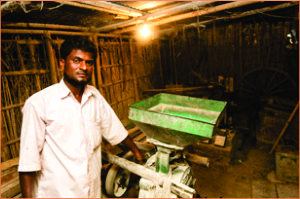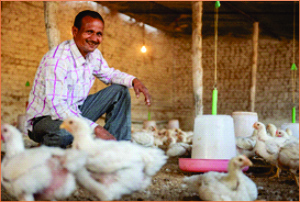|
Reimagining MSME Finance
in India Post COVID-19
The
effect of Covid-19 can be seen in an already dwindling world economy,
which is entering its worst phase since the Great Depression. The Indian
economy is no exception. The pandemic will further escalate the fiscal
deficit and growing non-performing assets (NPAs), and India will feel
the heat and so will its Micro, Small and Medium Enterprises (MSMEs).
MSMEs
contribute to nearly 30% of India’s GDP and employ about 110
 million
individuals1. The steep decline in the demand for their products and
services will be further accelerated due to excessive dependence on cash
based business operations, which is hindered by the nation-wide
lockdown. Limited availability of workers, low liquidity for working
capital and restriction on transportation will hamper procurement and
sales. The Government and Reserve Bank of India have started with a
considerate response with steps such as slashing interest rates,
introducing moratorium for term loans, easing working capital and
payment for employees from Employee Provident Fund (EPF). However, for a
sector which is constituted primarily by micro-enterprises (over 90% of
MSMEs are micro enterprises), these macroeconomic measures would not be
enough. Most of these enterprises are informal with less than five
employees and their dependence on formal sources of finance ranges from
low to nil. Hence, they will find it difficult to really benefit from
such provisions. million
individuals1. The steep decline in the demand for their products and
services will be further accelerated due to excessive dependence on cash
based business operations, which is hindered by the nation-wide
lockdown. Limited availability of workers, low liquidity for working
capital and restriction on transportation will hamper procurement and
sales. The Government and Reserve Bank of India have started with a
considerate response with steps such as slashing interest rates,
introducing moratorium for term loans, easing working capital and
payment for employees from Employee Provident Fund (EPF). However, for a
sector which is constituted primarily by micro-enterprises (over 90% of
MSMEs are micro enterprises), these macroeconomic measures would not be
enough. Most of these enterprises are informal with less than five
employees and their dependence on formal sources of finance ranges from
low to nil. Hence, they will find it difficult to really benefit from
such provisions.
According to the Economic Survey 2017-182, data on credit disbursed by
banks shows that out of a total outstanding credit of INR 26,041 billion
in November 2017, MSMEs got only 17.4% of the total credit. Also, as per
a survey conducted by Reserve Bank of India in 20183, as compared to
smaller MSMEs with a turnover of less than ₹10 lakhs, larger sized firms
were found to have higher probabilities of having formal funding as the
most important source. The on-going crisis has exposed the fault lines
in the current credit system and is a good time to revisit our lending
priorities. It is imperative for the government and mainstream financial
institutions to safeguard the interest of these micro-enterprises. Some
of the key initiatives that can be undertaken are as follows:
-
Measures to
enhance access to credit - Formal credit channels such as banks and NBFCs will need to play a much larger role in making financing easily
available to the MSME sector. MSME credit already forms a very small
percentage of the total outstanding bank credit with credit growth to
this sector showing signs of decline much before the pandemic struck.
Structural changes to lending practices for this sector are well
overdue.
-
Solving the
liquidity crunch - Since most of the micro-enterprises depend upon
regular cash flows for running their business, solving their liquidity
crunch during and post lockdown should be the top-most priority. But
since these units are mostly informal and have minimum ties to formal
sources of credit, government will have to leverage local social
infrastructures like Self Help Groups & their Federations, Farmer
Producer Organisations (FPOs), Panchayats and related institutions,
local Co-operatives and Civil Society Organisations’ (CSOs) network to
lend immediate support to these micro-enterprises for fulfilling their
working capital requirements. The government, corporates and private
financiers can also come together to create emergency funds which can
leverage the above channels to transfer funds directly to the
entrepreneurs through innovative financial instruments.
-
Lending via
innovation - Once the lockdown restrictions are lifted, it will be
important for government and mainstream financial institutions to
support these entrepreneurs to stabilise their businesses by fulfilling
their credit requirements. However, lack of proper documentation and
difficulty in credit assessment restricts access to formal finance for a
large proportion of micro-entrepreneurs. Hence, to reach the maximum
entrepreneurs and cater to their credit requirements, the following two
basic steps are required:
-
Use
alternative credit history mechanisms such as cash flow history,
enterprise potential / scope, community ratings etc. to assess a
borrower. The traditional FIs can use the expertise of fin-tech
organisations to create a safe, profitable portfolio.
-
Strategic
tie-ups with a large network of Common Service Centers and Rural Bank
Outreach Centres (“Bank Mitras”) to ease the documentation process for
the rural entrepreneurs. It will provide a great opportunity to
formalise the micro-enterprise sector and the government should make the
most of the opportunity.
-
Providing a
cushion - The government should also provide wage support to
micro-enterprises by paying a part of the salaries of the employees,
beyond meagre relief through direct transfers through Jhan Dhan Yojna
and PM Kisan Yojna. It can also defer their utility bills like that of
electricity, gas, rent etc. for a certain period to reduce their
financial burden load. Also increase in moratorium period and flexible
EMIs can be facilitated by the government and mainstream financial
institutions.
-
Specific
measures for self-employed or owner-managed enterprises - It will be
critical that the self-employed MSME units like hawkers, small
shopkeepers, who do not fall into the regular or casual salaried workers
in other enterprises be given the safety net needed to navigate this
crisis. Government can approve such compensation subject to
demonstration of reduced income, for instance, by way of documented
decline in predicted revenue due to cancelled orders, restricted
movement of goods and labour etc. Businesses can be asked to draw up
cash flow forecasts for how they will operate if compensation were
provided for a fixed time-period.
India has
never seen a situation like this since its independence which makes it
hard for the policymakers to find instant solutions. In these tough
times, Development Alternatives (DA) and its network of partners are
committed to lend their support to the government at multiple levels.
DA, through its multiple initiatives across its areas of intervention,
is trying to help micro-entrepreneurs, migrants, daily wage earners and marginalised members of the communities to survive through this pandemic
and thrive after its effects begin to recede. It has also developed
plans for co-creating solutions which will help micro-entrepreneurs,
specifically in rural and semi-urban geographies to stabilise their
businesses and make them sustainable.
In
this time of emergency, it is important for the government, corporates,
civil society organisations and other stakeholders to work in tandem and
demonstrate their commitment towards creating rescue plans for the
micro-enterprises, the ‘backbone of the Indian economy’, because if they
fail to cope, it can have disastrous consequences for the Indian
economy. It is also imperative that a strategy be drawn up to allow
businesses to reopen operation in a phased manner, with social
distancing norms in place. Government, institutions and businesses -
both large and small - will have to work together to ensure workers'
safety, be prepared for risk management in terms of phased restructuring
of business operations and be prepared and open to systemic changes in
business activity.
■
References:
-
https://www.cii.in/Sectors.aspx?enc=prvePUj2bdMtg
TmvPwvisYH+5EnGjyGXO9hLECvTuNuXK6QP3tp4gPGuPr/xpT2f
-
http://mofapp.nic.in:8080/economicsurvey /pdf/000_
Preface_Ten_Facts_2017-18_Vol_1-18_pages.pdf
-
https://www.rbi.org.in/scripts/Annual
ReportPublications .aspx?Id=1231
-
Annual
Report - MoMSME 2018-19 - https://msme.gov.in/ sites/default/files/
Annualrprt.pdf
Munir Ahmed Tahir
matahir@devalt.org
and Saubhagya Raizada
sraizada@devalt.org
Back to Contents
|
 million
individuals1. The steep decline in the demand for their products and
services will be further accelerated due to excessive dependence on cash
based business operations, which is hindered by the nation-wide
lockdown. Limited availability of workers, low liquidity for working
capital and restriction on transportation will hamper procurement and
sales. The Government and Reserve Bank of India have started with a
considerate response with steps such as slashing interest rates,
introducing moratorium for term loans, easing working capital and
payment for employees from Employee Provident Fund (EPF). However, for a
sector which is constituted primarily by micro-enterprises (over 90% of
MSMEs are micro enterprises), these macroeconomic measures would not be
enough. Most of these enterprises are informal with less than five
employees and their dependence on formal sources of finance ranges from
low to nil. Hence, they will find it difficult to really benefit from
such provisions.
million
individuals1. The steep decline in the demand for their products and
services will be further accelerated due to excessive dependence on cash
based business operations, which is hindered by the nation-wide
lockdown. Limited availability of workers, low liquidity for working
capital and restriction on transportation will hamper procurement and
sales. The Government and Reserve Bank of India have started with a
considerate response with steps such as slashing interest rates,
introducing moratorium for term loans, easing working capital and
payment for employees from Employee Provident Fund (EPF). However, for a
sector which is constituted primarily by micro-enterprises (over 90% of
MSMEs are micro enterprises), these macroeconomic measures would not be
enough. Most of these enterprises are informal with less than five
employees and their dependence on formal sources of finance ranges from
low to nil. Hence, they will find it difficult to really benefit from
such provisions.